BUSINESS ToBRFV
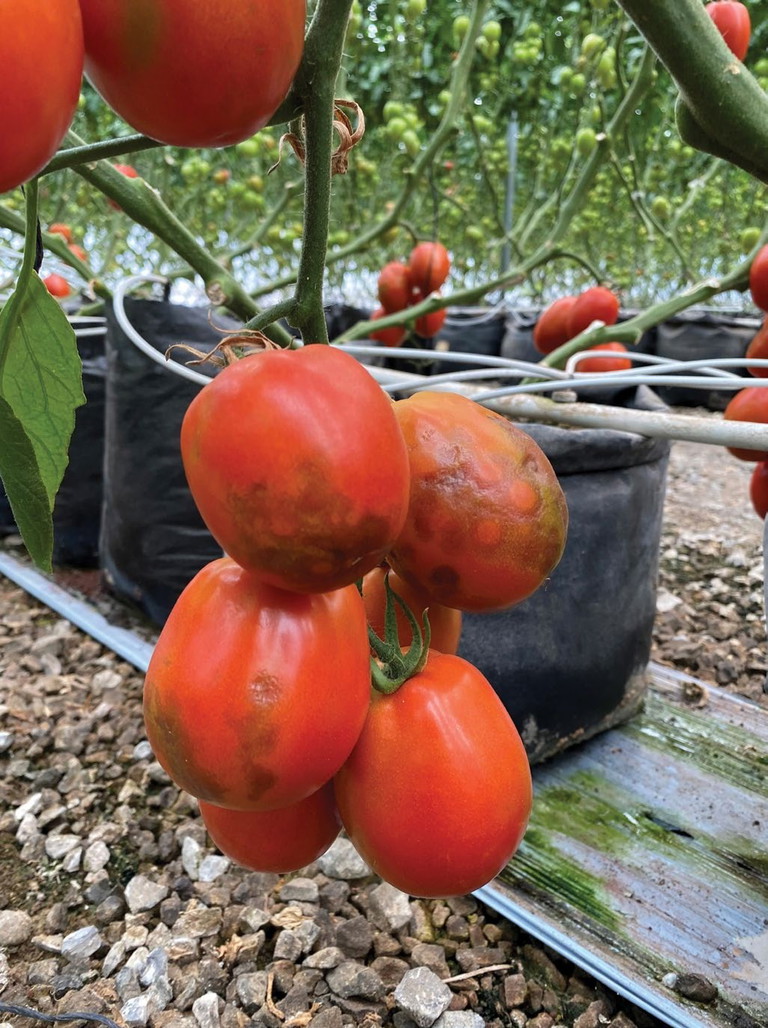
Western Australia remains free from ToBRFV. Extensive testing of production areas from Carnarvon in the north to Donnybrook in the south returned no positive results.
PHOTOGRAPHY © Used with permission
Staying ahead of
TOMATO BROWN RUGOSE FRUIT VIRUS
What WA growers need to know
Growers across Australia are keeping a close eye on a plant virus that’s been making headlines — tomato brown rugose fruit virus (ToBRFV). While the virus has been detected in South Australia, Victoria and New South Wales, Western Australia remains free of ToBRFV.
Words Marcus Visic, Plant Biosecurity Communications Manager, Plant Biosecurity, Biosecurity and Emergency Management, DPIRD
What is ToBRFV and why does it matter?
TOBRFV is a highly contagious virus that affects tomatoes, capsicums, and chillies. It causes symptoms like mosaic patterns, yellowing, and deformities on leaves, and brown wrinkled patches, uneven ripening, and deformations on fruit. These symptoms can cause serious economic damages to crops, by significantly reducing both yield and marketability of fruit.
There is no risk to food safety or human health from eating tomatoes with this virus.
Detection in Australia
ToBRFV was originally detected in August 2024 in South Australia. In January 2025 the virus was also detected in Victoria linked to a direct movement of tomato seedlings from SA.
On 29 May 2025, the Australian federal, state, and territory governments, together with affected industries — including commercial tomato growers, home gardeners, nursery operators, research institutions, and plant pathology services — agreed that eradicating ToBRFV from Australia was not technically feasible.
ToBRFV was detected in New South Wales in July 2025, following the earlier detections in SA (August 2024) and Victoria (January 2025).
Following the detection of ToBRFV in SA, DPIRD introduced import requirements for any host fruit, nursery stock or seed (and packaging) to manage the biosecurity risk to Western Australia. These arrangements remain in place.
WA remains free from ToBRFV. Extensive testing of production areas from Carnarvon in the north to Donnybrook in the south returned no positive results.
This encouraging outcome shows that current measures are working. However, continued vigilance is essential to keep WA free from ToBRFV.
How does it spread?
ToBRFV spreads easily through:
• Contaminated tools, equipment, hands and clothing
• Direct plant-to-plant contact
• Grafting and cuttings
• Irrigation water
• Seeds and seedlings
The virus can survive for months on surfaces, in soil, and in plant waste. Once a crop is infected, eradication typically involves destroying all affected plants and materials.
Advice to WA growers?
Although ToBRFV has not been detected in WA, growers can take steps now to protect their farms. These practices are good biosecurity habits regardless of the disease:
1. Source wisely
• Buy seed, seedlings, and graft material from trusted suppliers.
• Ask suppliers about their testing protocols for ToBRFV.
• Keep records of all farm inputs, including seed sources.
2. Monitor and report
• Regularly inspect crops for unusual symptoms.
• Familiarise yourself with signs of ToBRFV — especially yellowing, mottling, and wrinkled fruit.
• ToBRFV is a notifiable pest in WA. If you see anything unusual in your crops — or even suspect the presence of ToBRFV — you are legally required to report it. Reports can be made via the MyPestGuide®
Reporter app or online at mypestguide.agric.wa.gov.au, or contact the Pest and Disease Information Service on (08) 9368 3080 or at padis@ dpird.wa.gov.au. Early reporting helps protect your business and your neighbours.
3. Practice good hygiene
• Wash hands thoroughly (at least 60 seconds) before and after handling plants.
• Clean clothes in hot water (above 90°C).
• Disinfect tools and equipment using a 1% sodium hypochlorite solution (1 part pool chlorine to 10 parts water).
• Clean packaging, bins, and pallets regularly.
4. Control potential hosts
• Control wild or self-seeded tomato plants and other known hosts like petunia hybrids, fat hen, and nightshade species.
• Maintain clean and weed-free growing areas.
Familiarise yourself with signs of ToBRFV — especially yellowing, mottling, and wrinkled fruit.
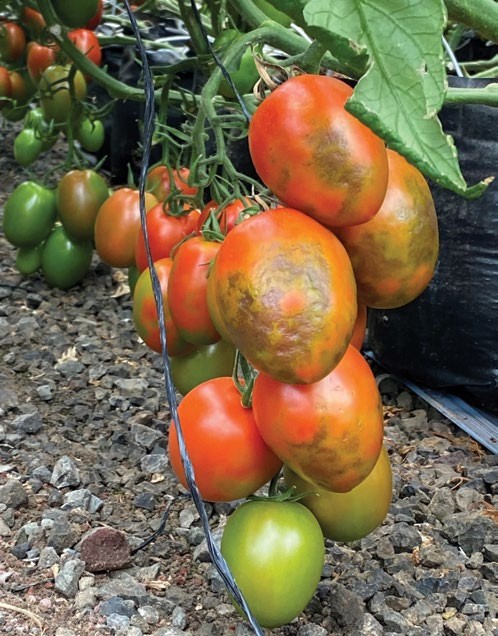
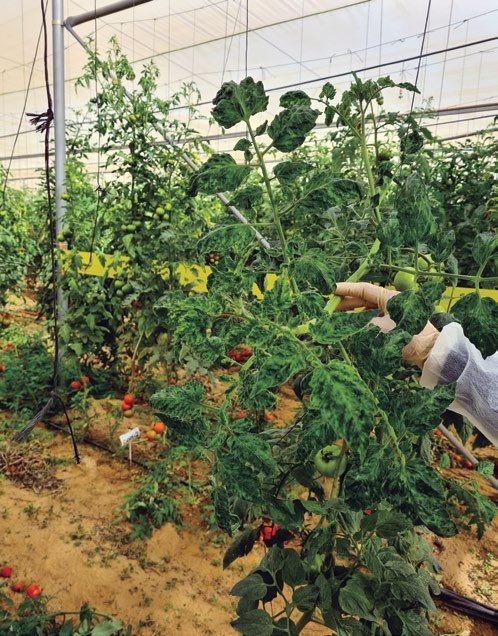

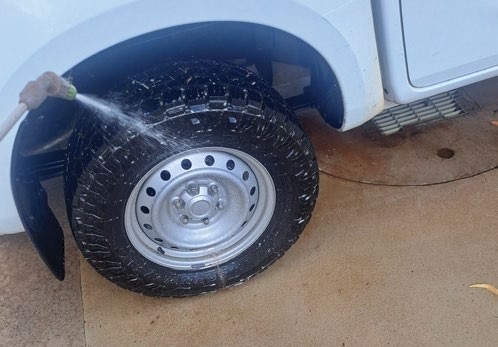
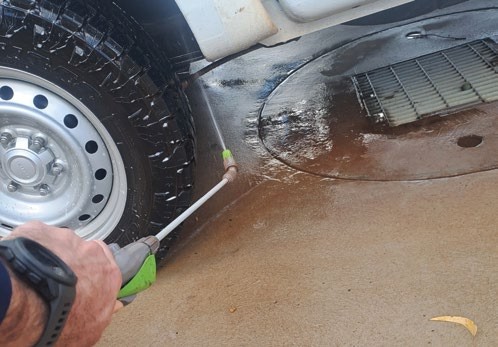
Cleaning and disinfecting protocol: (top) boot cleaning station, (middle and bottom) thoroughly clean car tyres and undercarriage.
PHOTOGRAPHY DPIRD
5. Train your team
• Make sure staff and visitors understand and follow your biosecurity protocols.
• Provide clear signage and hygiene stations around your property.
Protect what you’ve built — and WA’s clean reputation
Every farm in WA is part of a unique advantage: we remain free from ToBRFV and many other serious pests. That “clean, green” status opens markets, keeps yields high, and protects the reputation you’ve worked years to build.
Biosecurity isn’t just about one pest. It’s our first line of defence against all threats — whether they arrive on a visitor’s boots, in a seed packet, or on a piece of equipment. The habits we build now protect harvests, income, and future market access.
The cost of inaction is real. A single outbreak can mean destroyed crops, closed market doors, and years of rebuilding trust with buyers. Across Australia, growers who acted early on hygiene and sourcing stopped pests before they spread — saving not just their own farms, but entire regions.
The good news? You can protect your farm with simple, low-cost steps:
• Disinfect tools and equipment regularly.
• Source seed, seedlings and graft material from trusted suppliers.
• Keep clear records of all farm inputs.

Report your observations
MyPestGuide® Reporter
via app or online mypestguide.dpird.wa.gov.au
Pest and Disease Information Service
08 9368 3080 padis@dpird.wa.gov.au
For more practical tips, visit farmbiosecurity.com.au — a grower focused resource with checklists, guides and videos to help you reduce the risk of diseases, pests and weeds.
A practical next step:
• Enhance your biosecurity plan by adopting an additional routine measure — for example, disinfecting secateurs daily or setting up a boot-cleaning station. Consistent application of these measures is key to maintaining WA’s pest-free status.
Working together, we can keep WA’s clean reputation strong for years to come.
Looking ahead
Nationally, the approach to ToBRFV has shifted from eradication to management. For WA growers, the best defence is prevention.
Stay informed, stay clean, and stay connected with industry updates. Your vigilance helps protect not just your farm, but the entire Western Australian horticulture community.